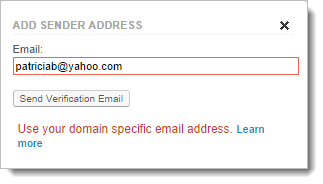Users can use an email address to send marketing emails and newsletters to subscribers who have signed up for the emails. Usually, a sender address is always a business email address and reflects the “From” part of an email creations so that the recipient can identify the sender of the email.
No, you cannot use public email address as sender address. A public email address is the one provided by email service providers such as Gmail, Yahoo, AOL, Hotmail, etc. and carries the public domains in the email addresses.
This restriction is because, in recent times companies like Yahoo and AOL have made a significant change in their email validation policy where they have increased their email security by strengthening their DMARC policy. According to this policy, they’ve clearly instructed the other email service clients to reject the mails that come from Yahoo/AOL sender address but not sent from Yahoo/AOL servers. If you attempt to use a public email address you will get the following messages:



In last few years, there has been an increase in email based forgeries such as email spoofing, account hacking, and phishing attacks to acquire account credentials, and credit card details.
In order to avoid this, Yahoo and AOL decided to increase the email security by sending emails in a secure way and reduce the chance for a spammer or hacker to send malicious or unsolicited messages.
Now, coming to the core part of this whole article, does it make any impact on the email deliverability? Well, the answer is YES! It does. Let us take a look at its impact.
An email with your own domain specific email address is more likely to get opened rather than one sent from a public email address.
To put it simpler, if a subscriber receives an email from patricia.b@gmail.com, he would really wonder about the origin of the email and would mark it spam. Contrary to that, if the sender address is patricia.b@zillum.com, then your subscriber can easily figure out the origin based on familiarity with the domain.
There are two ways of dealing with this policy so that you remain unaffected.
You can create your own domain specific sender address (es) rather than using Yahoo domain.
For instance, if your registered domain is zillum.com, we recommend going for a sender address such as patricia.b@zillum.com rather than patricia.b@yahoomail.com or patricia.b@aol.com.
Another suggestion is to authenticate your email domains using SPF and DKIM – the advanced email authentication methods to improve the email deliverability.
A domain specific email address is an email address ending in your web address rather than a public domain such as Yahoo, AOL, Gmail, etc. Let us look at some more benefits of using an email address with your domain.
Email authentication | How to authenticate a domain? | SPF | DKIM